A flip-flop is implemented as a bi-stable multivibrator; therefore, Q and Q' are guaranteed to be the inverse of each other for all inputs except S=1, R=1, which is not allowed. The excitation table for the SR flip-flop is helpful in understanding what occurs when signals are applied to the inputs.
S R Q(t) Q(t+1)
----------------
0 x 0 0
1 0 0 1
0 1 1 0
x 0 1 1
The outputs Q and Q' will rapidly change states and come to rest at a steady state after signals have been applied to S and R.
Example 1: Q(t) = 0, Q'(t) = 1, S = 0, R = 0.
State 1: Q(t+1 state 1) = NOT(R OR Q'(t)) = NOT(0 OR 1) = 0
Q'(t+1 state 1) = NOT(S OR Q(t)) = NOT(0 OR 0) = 1
State 2: Q(t+1 state 1) = NOT(R OR Q'(t+1 state 1)) = NOT(0 OR 1) = 0
Q'(t+1 state 2) = NOT(S OR Q(t+1 state 1)) = NOT(0 OR 0) = 1
Since the outputs did not change, we have reached a steady state; therefore, Q(t+1) = 0, Q'(t+1) = 1.
Example 2: Q(t) = 0, Q'(t) = 1, S = 0, R = 1
State 1: Q(t+1 state 1) = NOT(R OR Q'(t)) = NOT(1 OR 1) = 0
Q'(t+1 state 1) = NOT(S OR Q(t)) = NOT(0 OR 0) = 1
State 2: Q(t+1 state 2) = NOT(R OR Q'(t+1 state 1)) = NOT(1 OR 1) = 0
Q'(t+1 state 2) = NOT(S OR Q(t+1 state 1)) = NOT(0 OR 0) = 1
We have reached a steady state; therefore, Q(t+1) = 0, Q'(t+1) = 1.
Example 3: Q(t) = 0, Q'(t) = 1, S = 1, R = 0
State 1: Q(t+1 state 1) = NOT(R OR Q'(t)) = NOT(0 OR 1) = 0
Q'(t+1 state 1) = NOT(S OR Q(t)) = NOT(1 OR 0) = 0
State 2: Q(t+1 state 2) = NOT(R OR Q'(t+1 state 1)) = NOT(0 OR 0) = 1
Q'(t+1 state 2) = NOT(S OR Q(t+1 state 1)) = NOT(1 OR 0) = 0
State 3: Q(t+1 state 3) = NOT(R OR Q'(t+1 state 2)) = NOT(0 OR 0) = 1
Q'(t+1 state 3) = NOT(S OR Q(t+1 state 2)) = NOT(1 OR 1) = 0
We have reached a steady state; therefore, Q(t+1) = 1, Q'(t+1) = 0.
Example 4: Q(t) = 1, Q'(t) = 0, S = 1, R = 0
State 1: Q(t+1 state 1) = NOT(R OR Q'(t)) = NOT(0 OR 0) = 1
Q'(t+1 state 1) = NOT(S OR Q(t)) = NOT(1 OR 1) = 0
State 2: Q(t+1 state 2) = NOT(R OR Q'(t+1 state 1)) = NOT(0 OR 0) = 1
Q'(t+1 state 2) = NOT(S OR Q(t+1 state 1)) = NOT(1 OR 1) = 0
We have reached a steady state; therefore, Q(t+1) = 1, Q'(t+1) = 0.
Example 5: Q(t) = 1, Q'(t) = 0, S = 0, R = 0
State 1: Q(t+1 state 1) = NOT(R OR Q'(t)) = NOT(0 OR 0) = 1
Q'(t+1 state 1) = NOT(S OR Q(t)) = NOT(0 OR 1) = 0
State 2: Q(t+1 state 2) = NOT(R OR Q'(t+1 state 1)) = NOT(0 OR 0) = 1
Q'(t+1 state 2) = NOT(S OR Q(t+1 state 1)) = NOT(0 OR 1) = 0
We have reached a steady; state therefore, Q(t+1) = 1, Q'(t+1) = 0.
With Q=0, Q'=0, S=0, and R=0, an SR flip-flop will oscillate until one of the inputs is set to 1.
Example 6: Q(t) = 0, Q'(t) = 0, S = 0, R = 0
State 1: Q(t+1 state 1) = NOT(R OR Q'(t)) = NOT(0 OR 0) = 1
Q'(t+1 state 1) = NOT(S OR Q(t)) = NOT(0 OR 0) = 1
State 2: Q(t+1 state 2) = NOT(R OR Q'(t+1 state 1)) = NOT(0 OR 1) = 0
Q'(t+1 state 2) = NOT(S OR Q(t+1 state 1)) = NOT(0 OR 1) = 0
State 3: Q(t+1 state 3) = NOT(R OR Q'(t+1 state 2)) = NOT(0 OR 0) = 1
Q'(t+1 state 3) = NOT(S OR Q(t+1 state 2)) = NOT(0 OR 0) = 1
State 4: Q(t+1 state 4) = NOT(R OR Q'(t+1 state 3)) = NOT(0 OR 1) = 0
Q'(t+1 state 4) = NOT(S OR Q(t+1 state 3)) = NOT(0 OR 1) = 0
...
As one can see, a steady state is not possible until one of the inputs is set to 1 (which is usually handled by power-on reset circuitry).
If we examine simplest implementation of an SR flip-flop (see http://en.wikipedia.org/wiki/File:Transistor_Bistable_interactive_animated_EN.svg), we discover that it is composed of two bi-polar junction transistors (BJTs) and four resistors (replace the SPST toggle switches to ground with SPDT switches that can switch the set and reset lines between ground potential and V+). The BJTs are configured as common emitter inverters. The collector (output) of each transistor is fed back into the base (input) of the opposite transistor. The input S is wire-ORed with the output of the BJT whose collector connection serves as the output Q (the junction of R1/R3). The input R is wire-ORed with the output the BJT whose collector connection serves as the output Q' (the junction of R2/R4).
When the circuit first powers up, neither transistor is forward-biased into the saturation region for a tiny fraction of a second, which means that both Q and Q' are at logic level 1. The voltage available at each collector is fed to the base of the opposite transistor, which causes it to become forward biased into the saturation region. The transistor that becomes forward-biased first will start conducting current first, which, in turn, will cause a voltage drop to occur across its collector resistor, setting its output to logic level 0. This drop in collector voltage will prevent the opposite transistor from becoming forward-biased; therefore, setting the initial state of the flip-flop. It’s basically a hardware race condition that leads to an unpredictable outcome.


